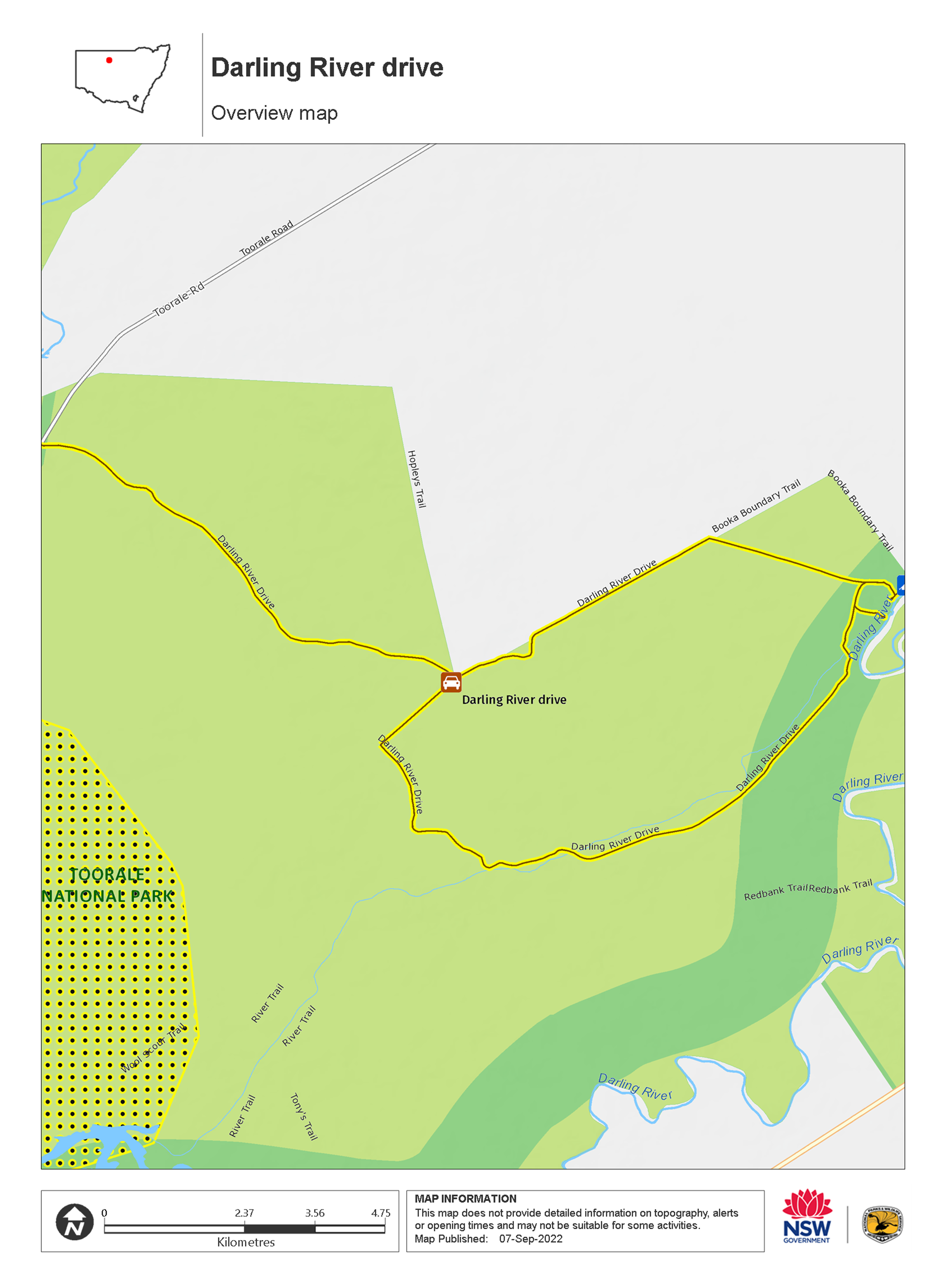Darling River drive
Toorale National Park
Overview
Darling River drive showcases the natural beauty of meandering Darling River as well as Toorale National Park and State Conservation Area – perfect for 4WD adventurers and independent travellers.
- Where
- Toorale National Park in Outback NSW
- Distance
- 41km loop
- Time suggested
- 1hr 30min
- Grade
- Medium
- What to
bring - Drinking water
- Please note
- Remember to take your binoculars if you want to go birdwatching.
- The weather in the area can be extreme and unpredictable, so please ensure you’re well-prepared for your visit. Check the weather before you set out as the road to Toorale National Park can become impassable when it rains.
- This park or attraction is in a remote location, so please ensure you’re well-prepared, bring appropriate clothing and equipment and advise a family member or friend of your travel plans.
- Ensure you bring plenty of water for drinking and cooking.
- There is limited/no mobile reception in this park.
- Please respect the wishes of Kurnu-Baakandji People by protecting the natural and cultural features of the park.
Whether you know this scenic car touring circuit as Darling River drive or Yuthuru Paaka Thuru, the expanse of floodplain is just as awe-inspiring. After rain, the waterways come to life, providing excellent opportunities to go fishing and catch yellow belly and cod. You’ll travel through coolabah woodlands interspersed with lush wetlands, ideal for birdwatching, so pack your binoculars and look out for kookaburras calling the area home.
Enjoy a relaxing picnic or camp overnight and enjoy the vast star-filled sky as it fills with stars. In spring, masses of tiny white sunray daisies appear, and after the rains you’ll be treated to colourful wildflower displays of pigweed, native peas and bluebells.
Map

Map legend

Local alerts
For the latest updates on fires, closures and other alerts in this area, see https://www.nationalparks.nsw.gov.au/things-to-do/driving-routes/darling-river-drive/local-alerts
General enquiries
- National Parks Contact Centre
- 7am to 7pm daily
- 1300 072 757 (13000 PARKS) for the cost of a local call within Australia excluding mobiles
- parks.info@environment.nsw.gov.au
Park info
- in Toorale National Park in the Outback NSW region
Toorale National Park and SCA is always open, but may have to close at times due to poor weather or fire danger.
Visitor info
All the practical information you need to know about Darling River drive.
Maps and downloads
Learn more
Darling River drive is in Toorale National Park. Here are just some of the reasons why this park is special:
Birdwatching spectacular

After the rains, the vast natural floodplain springs to life and the wetlands bring an abundance of birdlife. A fabulous spot for birdwatching, bring your binoculars for the chance to see the iconic brolga, pink cockatoo, or the wide range of waterbirds such as the Australian pelican, pied cormorant and royal spoonbill.
Inland rivers

Toorale National Park marks the junction of two mighty inland rivers and provides one of only a few opportunities to access the Darling and Warrego rivers. Set up camp on the Darling riverbank, or spend a leisurely day checking out the local wildlife, birdwatching and fishing.
Rich pastoral history

A relative newcomer to the national park family, Toorale was purchased in 2008. The large pastoral station and woolshed changed hands many times, and many people have a historic connection to Toorale, including Henry Lawson, who worked on the station for a short period during the 1890s.
- Toorale Homestead precinct (Yarramarra) Toorale Homestead precinct (Yarramarra) is a must-see for outback travellers near Bourke. Built on the lands of the Kurnu-Baakandji People, Toorale Station was once part of the world’s largest sheep station.
The People of Darling River

This country between the Warrego and Darling rivers is of spiritual and cultural significance to Kurnu-Baakandji People. The name Baakandji comes from the word ‘paaka’, meaning ‘Darling River’, so Baakandji are the People belonging to Darling River. Take a Discovery tour to learn about the culture and heritage of the region as well as local bush tucker such as wild orange, quandongs, wild plum bush, wild bananas and bush tomatoes.

